NPY Y1 receptor is involved in ghrelin- and fasting-induced increases in foraging, food hoarding, and food intake
- PMID: 17204592
- PMCID: PMC3509278
- DOI: 10.1152/ajpregu.00597.2006
NPY Y1 receptor is involved in ghrelin- and fasting-induced increases in foraging, food hoarding, and food intake
Abstract
Fasting triggers a constellation of physiological and behavioral changes, including increases in peripherally produced ghrelin and centrally produced hypothalamic neuropeptide Y (NPY). Refeeding stimulates food intake in most species; however, hamsters primarily increase foraging and food hoarding with smaller increases in food intake. Fasting-induced increases in foraging and food hoarding in Siberian hamsters are mimicked by peripheral ghrelin, central NPY, and NPY Y1 receptor agonist injections. Because fasting stimulates ghrelin and subsequently NPY synthesis/release, it may be that fasting-induced increased hoarding is mediated by NPY Y1 receptor activation. Therefore, we asked: Can an Y1 receptor antagonist block fasting- or ghrelin-induced increases in foraging, food hoarding, and food intake? This was accomplished by injecting the NPY Y1 receptor antagonist 1229U91 intracerebroventricularly in hamsters fasted, fed, or given peripheral ghrelin injections and housed in a running wheel-based food delivery foraging system coupled with simulated-burrow housing. Three foraging conditions were used: 1) no running wheel access, free food, 2) running wheel access, free food, or 3) foraging requirement (10 revolutions/pellet) for food. Fasting was a more potent stimulator of foraging and food hoarding than ghrelin. Concurrent injections of 1229U91 completely blocked fasting- and ghrelin-induced increased foraging and food intake and attenuated, but did not always completely block, fasting- and ghrelin-induced increases in food hoarding. Collectively, these data suggest that the NPY Y1 receptor is important for the effects of ghrelin- and fasting-induced increases in foraging and food intake, but other NPY receptors and/or other neurochemical systems are involved in increases in food hoarding.
Figures
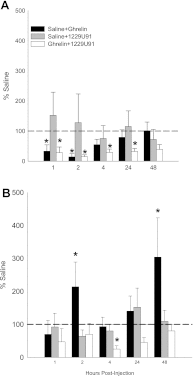
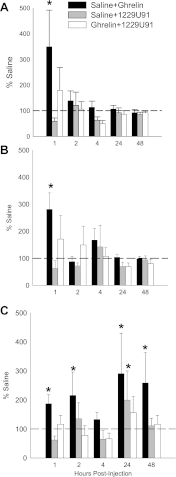
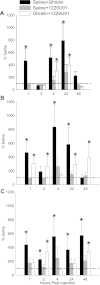
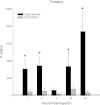
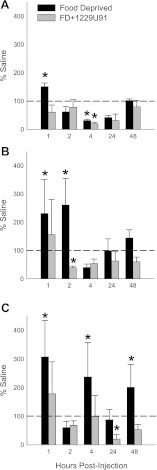
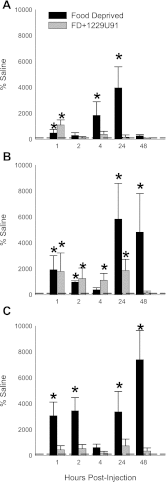
Similar articles
-
Neural and hormonal control of food hoarding.Am J Physiol Regul Integr Comp Physiol. 2011 Sep;301(3):R641-55. doi: 10.1152/ajpregu.00137.2011. Epub 2011 Jun 8. Am J Physiol Regul Integr Comp Physiol. 2011. PMID: 21653877 Free PMC article. Review.
-
MTII attenuates ghrelin- and food deprivation-induced increases in food hoarding and food intake.Horm Behav. 2007 Dec;52(5):612-20. doi: 10.1016/j.yhbeh.2007.07.014. Epub 2007 Aug 10. Horm Behav. 2007. PMID: 17826779 Free PMC article.
-
Peripheral ghrelin injections stimulate food intake, foraging, and food hoarding in Siberian hamsters.Am J Physiol Regul Integr Comp Physiol. 2005 Mar;288(3):R716-22. doi: 10.1152/ajpregu.00705.2004. Epub 2004 Dec 2. Am J Physiol Regul Integr Comp Physiol. 2005. PMID: 15576659
-
Role of NPY and its receptor subtypes in foraging, food hoarding, and food intake by Siberian hamsters.Am J Physiol Regul Integr Comp Physiol. 2005 Jul;289(1):R29-36. doi: 10.1152/ajpregu.00853.2004. Epub 2005 Feb 10. Am J Physiol Regul Integr Comp Physiol. 2005. PMID: 15705801
-
Neuroendocrine regulation of appetitive ingestive behavior.Front Neurosci. 2013 Nov 15;7:213. doi: 10.3389/fnins.2013.00213. Front Neurosci. 2013. PMID: 24298235 Free PMC article. Review.
Cited by
-
Arcuate nucleus destruction does not block food deprivation-induced increases in food foraging and hoarding.Brain Res. 2010 Apr 6;1323:94-108. doi: 10.1016/j.brainres.2010.01.078. Epub 2010 Feb 4. Brain Res. 2010. PMID: 20138163 Free PMC article.
-
Fish oil promotes survival and protects against cognitive decline in severely undernourished mice by normalizing satiety signals.J Nutr Biochem. 2011 Aug;22(8):766-76. doi: 10.1016/j.jnutbio.2010.07.001. Epub 2010 Dec 15. J Nutr Biochem. 2011. PMID: 21109417 Free PMC article.
-
Intracerebroventricular administration of C-type natriuretic peptide suppresses food intake via activation of the melanocortin system in mice.Diabetes. 2013 May;62(5):1500-4. doi: 10.2337/db12-0718. Epub 2012 Dec 28. Diabetes. 2013. PMID: 23274904 Free PMC article.
-
PYY(3-36) into the arcuate nucleus inhibits food deprivation-induced increases in food hoarding and intake.Peptides. 2013 Sep;47:20-8. doi: 10.1016/j.peptides.2013.05.005. Epub 2013 Jun 29. Peptides. 2013. PMID: 23816798 Free PMC article.
-
Neural and hormonal control of food hoarding.Am J Physiol Regul Integr Comp Physiol. 2011 Sep;301(3):R641-55. doi: 10.1152/ajpregu.00137.2011. Epub 2011 Jun 8. Am J Physiol Regul Integr Comp Physiol. 2011. PMID: 21653877 Free PMC article. Review.
References
-
- Ariyasu H, Takaya K, Tagami T, Ogawa Y, Hosoda K, Akamizu T, Suda M, Koh T, Natsui K, Toyooka S, Shirakami G, Usui T, Shimatsu A, Doi K, Hosoda H, Kojima M, Kangawa K, Nakao K. Stomach is a major source of circulating ghrelin, and feeding state determines plasma ghrelin-like immunoreactivity levels in humans. J Clin Endocrinol Metab 86: 4753–4758, 2001. - PubMed
-
- Asakawa A, Inui A, Kaga T, Yuzuriha H, Nagata T, Ueno N, Makino S, Fujimiya M, Niijima A, Fujino MA, Kasuga M. Ghrelin is an appetite-stimulatory signal from stomach with structural resemblance to motilin. Gastroenterology 120: 337–345, 2001. - PubMed
-
- Bartness TJ Food hoarding is increased by pregnancy, lactation, and food deprivation in Siberian hamsters. Am J Physiol Regul Integr Comp Physiol 272: R118–R125, 1997. - PubMed
-
- Bartness TJ, Clein MR. Effects of food deprivation and restriction, and metabolic blockers on food hoarding in Siberian hamsters. Am J Physiol Regul Integr Comp Physiol 266: R1111–R1117, 1994. - PubMed
-
- Bartness TJ, Day DE. Food hoarding: a quintessential anticipatory appetitive behavior. Prog Psychobiol Physiol Psychol 18: 69–100, 2003.
MeSH terms
Substances
LinkOut - more resources
Full Text Sources
Research Materials
Miscellaneous

